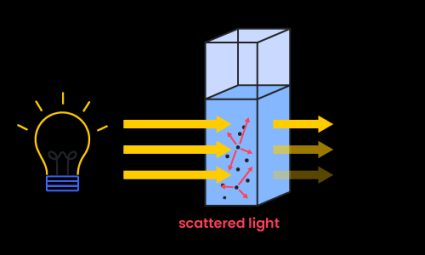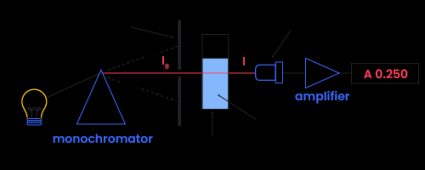Optical Density Calculator
The optical density calculator is created to assist you in finding the optical density 🔅 from known incident light intensity (I0) and transmitted light intensity (I). More than that, our tool will automatically calculate the absorbance and transmittance for you based on the optical density!
In this article, you will learn about:
- What is optical density;
- Optical density formula and examples;
- Optical density vs. absorbance;
- How do you calculate optical density? – OD calculator; and
- Applications of optical density.
What is optical density?
Have you ever noticed how some curtains let light pass through into the room more than others?🪟 If you have to choose curtains for your bedroom 🛏️, you would want those that completely keep the light out. But if you need to build an office space that gives you a nice and bright working environment, thinner curtains would be a better fit. Why are we talking about curtains? Let's find out with our OD calculator 😉

Definition
Optical density (OD), also known as optical absorbance, is the value indicating a material's property according to the speed of light passing through an optically dense medium. The mechanism that makes an object optically dense is its ability to maintain the electromagnetic waves in the form of electron vibrations before reemission into another medium.
- If object A is optically denser than object B, light transmits slower through A; thus
- B is optically rarer, meaning that light transmits quicker through B.
In other words, we can also say that:
- ↑ OD, ↓ speed of light; and
- ↓ OD, ↑ speed of light.
🤔 Going back to the curtains concept, curtains made of materials with a lower OD, like lightweight cotton, will allow more light to pass through compared to higher OD materials like blackout fabrics.
💡 The difference in speed of light and wavelength as it travels from one medium to another can lead to refraction. Check out Omni's index of refraction calculator and Snell's law calculator for more information.
Optical density formula — Practical examples
The optical density calculator was built based on the classic optical density formula:
where:
- — Optical density;
- — Incident light intensity; and
- — Transmitted light intensity.
As a logarithmic ratio, optical density has no units. Anyhow, the incident and transmitted light intensities must have the same units, whether they are light intensity units (cd, mW, W/m2, lx, etc.) or arbitrary units.
🔍 Are you wondering about how to calculate optical density? Practice makes progress, so let's progress together with some practical examples!
Example 1
In UV-Vis spectroscopy, the incident and transmitted light intensity of your sample is measured as follows: , and :
Example 2
While measuring the concentration of cells in your culture, the spectrophotometer measured and :
Example 3
What if the incident and transmitted light intensity are the same value? Let's say that and :
An optical density of 0 means that 100% of the incident light is transmitted and either means that the material is transparent or that it has no effect on the passage of light.
How do we know that 100% of the light is transmitted? Learn more about "transmittance" in the next section of the article.
Optical density vs. absorbance
Optical density and absorbance are terms representing very similar concepts, if not the same one! Both explain the interaction of light passing through a substrate, although in a slightly different manner.
Comparison
Since they are very similar, the two terms can be confusing. Don't worry! The optical density calculator has got your back 😉
Optical density — The ability of optically dense materials to slow down the speed of light passing through them.
Absorbance — The ability of a substrate to absorb light passing through it at a specific wavelength, leading to less transmission.
So, it can be said that they are different in terms of:
-
Point of measurement — Absorbance is measured at a specific wavelength, while optical density covers every aspect of light attenuation.
-
Light interactions — Absorbance only takes into account the light absorption, while optical density also includes other interactions like reflection and scattering.
-
Applications — Absorbance is used in chemical analysis and quantification in spectroscopy, while optical density is applied to lens design and microscopy. If you're interested in learning more, have a look at the !
Beer Lambert's equation
To calculate the absorbance, the equation from Beer-Lambert law is used:
Have you noticed that the only difference from the optical density equation is that there is no negative sign in the log? Hence, the relationship between absorbance and optical density is negative correlation, meaning that when one value increases, the other one decreases. Thus, we can conclude that:
- If increases ↑, decreases ↓; and
- If decreases ↓, increases ↑.
Transmittance
As a related concept to optical density and absorbance, percent transmittance is the amount of light transmitted by the object or substrate. It is represented by the following equation:
Does it look familiar? 🤔 Exactly, the percent transmittance, or the ratio between incident and transmitted light intensity, is used to calculate both optical density and absorbance!
How to calculate optical density – Optical density calculator
To use Omni's optical density calculator, follow these simple steps:
- Input the incident light intensity.
- Input the transmitted light intensity.
- That's it! The calculator will automatically give you the optical density, as well as absorbance and transmittance.
Applications of optical density
Optical density, interchangeably with absorbance, has many useful applications. The main common role is quantifying different substances in a sample and defining their concentration.
Spectrophotometry and spectroscopy
Samples of interest are prepared into a cuvette, and analyzed with a spectrophotometer. The absorbance noted is used to calculate the concentration with the equation: A = ε × b × c.

Hence, the use of optical density appears in uncountable fields such as:
-
Biochemistry and molecular biology — Quantifying nucleic acids, proteins, RNA, and/or DNA concentration.
-
Microbiology — Quantifying bacterial growth via the analysis of the diluted microbial culture into the spectrophotometer.
-
Environmental monitoring — Measuring the contamination or concentration in soil, wastewater, or samples from water bodies.
-
Biomedical applications — For instance, measuring the level of hemoglobin in blood samples.
What is optical density?
Optical density (OD) is the value indicating the ability of an optically dense object to maintain or delay the speed of light emitted through it in the form of electron vibrations before reemission into another medium.
Are optical density and absorbance the same thing?
More or less, they represent the same concept but in a different way. They both explain the interaction of light with a substrate.
The difference is that absorbance measures it at a specific wavelength, while optical density considers the overall interaction and takes into account other interactions like reflection, refraction, and scattering.
What is the difference between physical and optical density?
Physical density is a measure of material compactness, while optical density measures the amount of light absorbed or transmitted. Physical density has units of mass per unit volume; on the other hand, optical density is dimensionless.
How do I calculate the optical density?
To calculate the optical density, follow these simple steps:
-
Use the equation OD = −log(T), where T = I0/I (incident divided by transmitted light intensity).
-
Let's say that the transmission (T) = 2. Input the value into the equation: OD = −log(2).
-
Use a calculator or Omni's optical density tool to solve the log:
−log(2) = -0.301
-
That's your optical density!
How do I calculate the concentration from optical density?
To calculate the concentration of a substance using optical density or absorbance, use the equation:
c = A / (ε × b)
derived from:
A = ε × b × c
where:
- A — Absorbance;
- ε — Molar extinction coefficient;
- b — Path length of light; and
- c — Concentration of the substance.
What are optical density units?
Optical density is dimensionless and has no units. Since it is a representation of the attenuation of light as it passes through a medium, there are no units associated with it. Otherwise, we can think of optical density units as "arbitrary units" as well.